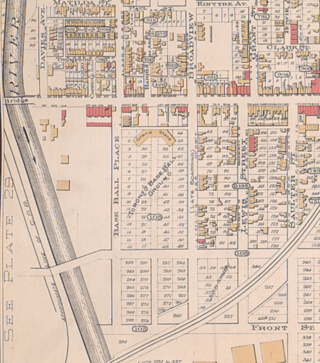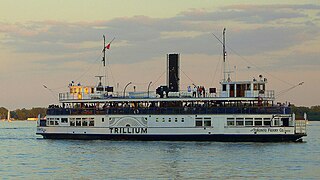
The Toronto Islands are a chain of 15 small islands in Lake Ontario, south of mainland Toronto, Ontario, Canada.

The Polo Grounds was the name of three stadiums in Upper Manhattan, New York City, used mainly for professional baseball and American football from 1880 through 1963. The original Polo Grounds, opened in 1876 and demolished in 1889, was built for the sport of polo. Bound on the south and north by 110th and 112th streets and on the east and west by Fifth and Sixth (Lenox) avenues, just north of Central Park, it was converted to a baseball stadium when leased by the New York Metropolitans in 1880.

Griffith Stadium stood in Washington, D.C., from 1911 to 1965, between Georgia Avenue and 5th Street, and between W Street and Florida Avenue NW.

Canadian National Exhibition Stadium was a multi-purpose stadium that formerly stood on the Exhibition Place grounds, in Toronto, Ontario, Canada. Originally built for Canadian National Exhibition events, the stadium served as the home of the Toronto Argonauts of the Canadian Football League, from 1959–1988, the Toronto Blue Jays of Major League Baseball from 1977–1989, and the Toronto Blizzard of the North American Soccer League from 1979–1983. The stadium hosted the Grey Cup game 12 times over a 24-year period.

Sunlight Park was the first baseball stadium in Toronto, Ontario, Canada. The all wood structure was built in 1886 at a cost of $7,000 by the International League baseball team the Toronto Baseball Club.

Maple Leaf Stadium was a jewel box-style baseball stadium in Toronto, Ontario, Canada, located at the foot of Bathurst Street on the south side of Lake Shore Boulevard. It was built in 1926 by Lol Solman for his Toronto Maple Leafs baseball team of the International League. Previously, the Maple Leafs had played at Hanlan's Point Stadium. It continued to be the home of the Leafs for 42 seasons, until the team left town following the 1967 season. The stadium was demolished in 1968. Fans often referred to the stadium as the "Fleet Street Flats".
Boundary Field, also known as American League Park II and National Park, is a former baseball ground in Washington, D.C. located on the site currently occupied by Howard University Hospital; bounded approximately by Georgia Avenue, 5th Street, W Street and Florida Avenue, NW. It was just outside what was then the city limit of Washington, whose northern boundary was Boundary Street which was renamed Florida Avenue in 1890.

The Toronto Island ferries connect the Toronto Islands in Lake Ontario to the mainland of Toronto, Ontario, Canada. The main city-operated ferry services carry passengers (all) and commercial vehicles (some) from the Jack Layton Ferry Terminal at the foot of Bay Street to three docks on the islands. Private motor vehicles are not carried. The ferry operated by PortsToronto carries passengers and vehicles to Billy Bishop Toronto City Airport on the island from the foot of Eireann Quay. Additional private ferries carry passengers to various island boat clubs. Ferry services to the islands began in 1833, and the Toronto Island Ferry Company began in 1883.

The Toronto Maple Leafs were a high-level minor league baseball club located in Toronto, Ontario, Canada, which played from 1896 to 1967.

Hanlan's Point Beach is a public beach situated on Hanlan's Point in the Toronto Islands near Toronto, Ontario on the shore of Lake Ontario. A 1 kilometre-long part of the beach was officially recognized by the city in 2002 as being clothing optional.

Lawrence "Lol" Solman was a prominent businessman in Toronto, Ontario, Canada.

Vaughn Street Park was a baseball park in the northwest United States, located in Portland, Oregon. Opened in 1901, it lasted for over a half century and was torn down in 1956. Its primary tenant was the Portland Beavers of the Pacific Coast League (PCL). During a stretch when the club was tagged as the "Lucky Beavers", the ballpark was also sometimes called Lucky Beavers Stadium.

Sunnyside Amusement Park was a popular amusement park in Toronto, Ontario, Canada that ran from 1922 to 1955, demolished in 1955 to facilitate the building of the Metro Toronto Gardiner Expressway project. It was located on the Lake Ontario waterfront at the foot of Roncesvalles Avenue, west of downtown Toronto.

Trillium is a side wheeler ferry operated by the City of Toronto Parks, Forestry and Recreation, in Toronto, Ontario, Canada. Now 112 years old, she is one of several Toronto Island ferries operating between the Jack Layton Ferry Terminal at Bay Street and Queens Quay and three landing points on the Toronto Islands. She is the last sidewheel-propelled vessel on the Great Lakes.

Hamtramck Stadium, also known as Roesink Stadium is one of only 12 remaining Negro league baseball stadiums. It is located at 3201 Dan Street, in Veterans Park, in Hamtramck, Michigan. The stadium was listed on the National Register of Historic Places in 2012. The stadium is located near, and occasionally confused with, Keyworth Stadium. The stadium was rededicated on June 20, 2022, as part of the Juneteenth celebration. In 2020, the stadium's field was renamed Norman "Turkey" Stearnes Field, after Detroit Stars player Turkey Stearnes.
The 1977 Major League Baseball expansion resulted in the establishment of expansion franchises in Seattle and Toronto in the American League of Major League Baseball. The Seattle Mariners and Toronto Blue Jays began play in the 1977 Major League Baseball season, becoming the 25th and 26th teams in Major League Baseball.

The Gibraltar Point Blockhouse was a blockhouse that was originally built in 1794 and was located on Gibraltar Point at the western end of the Toronto Islands. The first Lieutenant Governor of Upper Canada, John Graves Simcoe, planned defences for the mouth of Toronto Harbour at Fort York, along with the Gibraltar Point Blockhouse that was situated south of the harbour's entrance.

Diamond Park was a baseball stadium in Toronto, Ontario, Canada. It was the home of the Toronto Maple Leafs professional baseball club from 1901 until 1907. It was located at the south-east corner of Liberty Street and Fraser Avenue. The stadium was also used for rugby football and lacrosse.

Bluebell was a ferry built in Toronto, Ontario, Canada by Polson Iron Works for the Toronto Ferry Company. She was a steam-powered vessel, propelled by side-wheels. She ferried passengers between the Toronto mainland and the Toronto Islands.




















